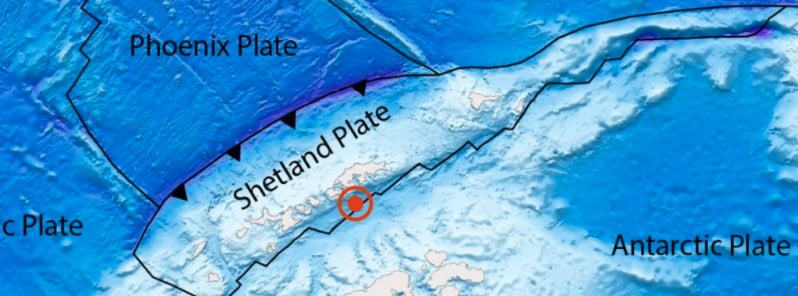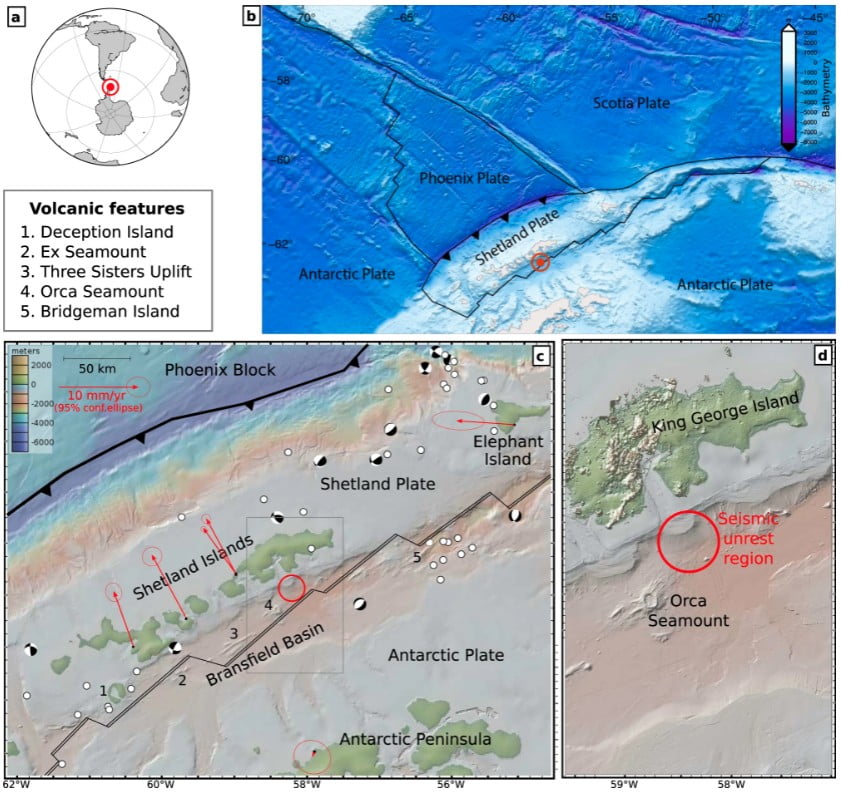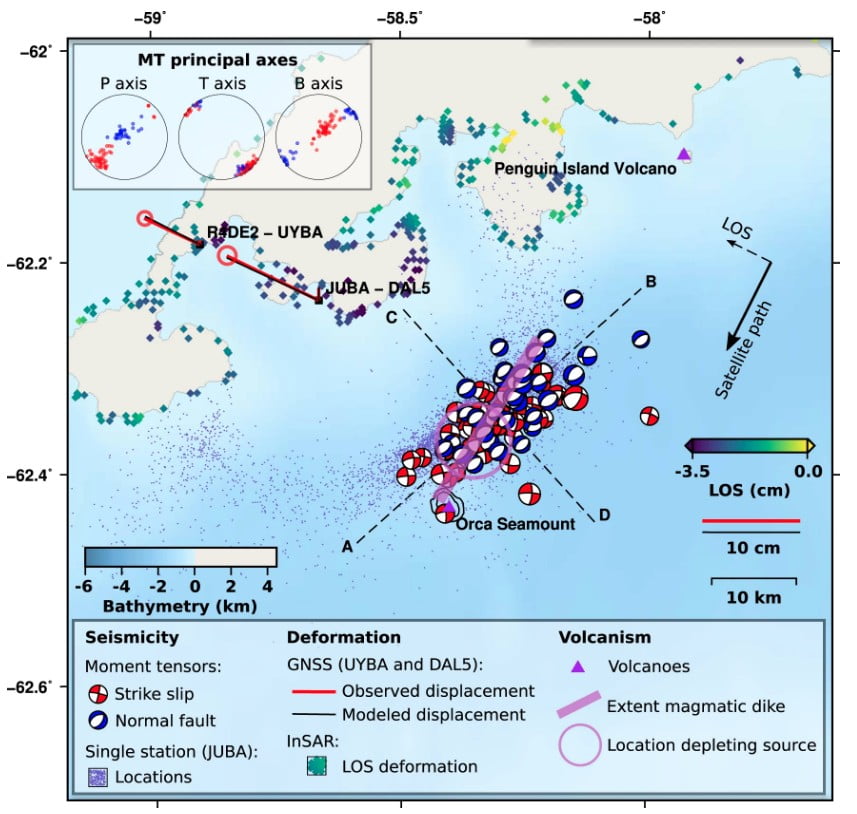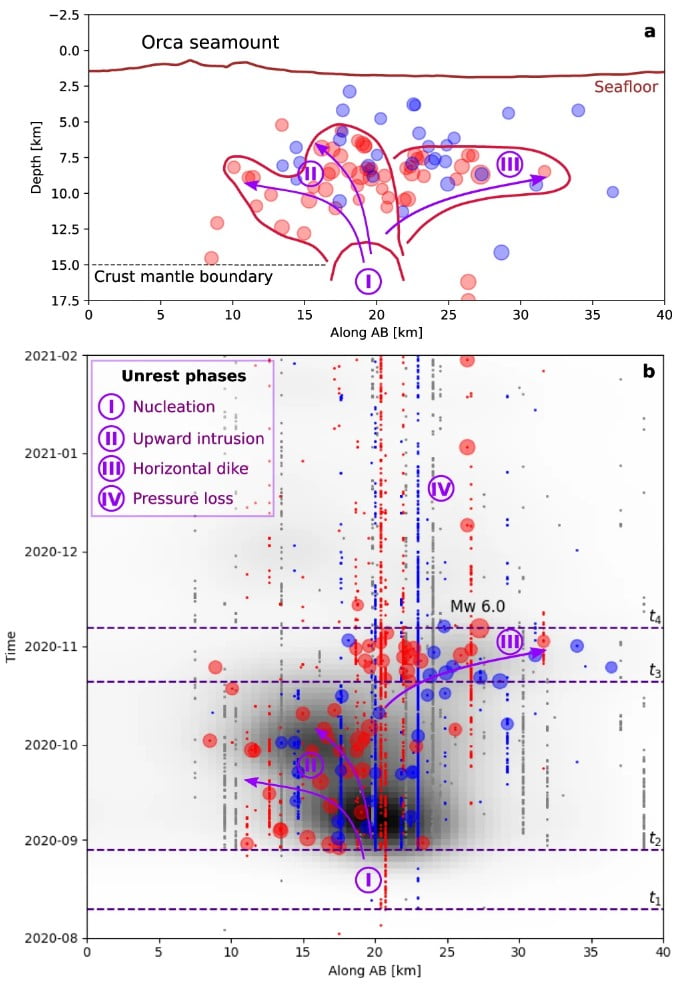Massive earthquake swarm in Antarctica driven by magmatic intrusion at Orca volcano

New research published in Nature determined that an intense earthquake swarm at the Bransfield Strait, Antarctica in 2020/21 was caused by the rapid transfer of magma from the Earth’s mantle near the crust-mantle boundary to almost the surface.
- The swarm started in August 2020 with 128 M4+ earthquakes and counted approximately 85 000 before it was over in 2021.
- The swarm was located close to the Orca submarine volcano, previously considered inactive.
- There was no evidence of similar volcanic swarms in the past experiments: even if the off-shore volcanism and extensional tectonics could sometimes increase the seismic rate in the back-arc basin, a comparably energetic swarm has never been recorded in the region.
During its early phase, 3 186 earthquakes were reported, based on the analysis of seismic data at a local station. The swarm peaked with two large earthquakes – M5.9 on October 2 and M6.0 on November 6.
The estimated seismic moment released from August 2020 to February 2021 was ~3.88 × 1018 Nm which is equivalent to Mw 6.4.
The seismicity was localized close to the Orca seamount, a seafloor caldera shield volcano of 900 m (2 950 feet) bathymetric height offshore the coast of King George Island, where earthquakes were felt at Antarctic bases.
While the nearby plate boundaries and rift are seismically active and hosted swarm episodes of presumed magmatic origin, earthquakes there are typically moderate.

The South Shetland Islands – Antarctic Peninsula region hosts the remnant segment of a formerly larger subduction zone, which is today limited to the Phoenix block segment.
The Bransfield Basin, which separates the South Shetland Islands and the Antarctic Peninsula lies in a unique tectonic environment.
Although active subduction occurred during most of the past 200 million years, it slowed dramatically at about 4 million years ago when the Phoenix-Antarctic spreading center was abandoned offshore, leaving a small remnant of the former Phoenix plate incorporated into the Antarctic plate.
Even though geochemical data indicate that unaltered basalt dredged from the Bransfield basin is like midocean ridge basalt, there is no clear evidence for normal seafloor spreading.

“We resolve further details of the seismicity distribution: strike-slip events are spatially clustered NE of the Orca volcano, while normal faulting events further extend along a narrow band oriented NE-SW,” the researchers noted.
Centroid depths, which are resolved with an average uncertainty of 2 – 3 km (1.2 – 1.9 miles), indicate that the seismicity was shallow, rarely exceeding 15 km (9.3 miles).
GNSS and InSAR data along King George Island coastline show a transient surface deformation from August 2020 and persisting over months superposed to the background spreading rate, which researchers estimated as 2.1 cm (0.8 inches) per year.
Researchers concluded that the magmatic intrusion must have been fed by a deeper reservoir, which should presumably lay at least at ~20 km (12 miles) below a region located NE off the Orca seamount, where the first seismic sign of unrest appeared.
“The depletion of such reservoir should produce a deformation signal with the opposite sign compared to the dike opening, as recently observed offshore Mayotte, Comoro Islands.”

A seafloor eruption is likely, but not confirmed by sea surface temperature anomalies, the researchers said.
The unrest documents episodic magmatic intrusion in the Bransfield Strait, providing unique insights into active continental rifting.
Reference:
Massive earthquake swarm driven by magmatic intrusion at the Bransfield Strait, Antarctica – Simone Cesca et al. – Nature / Communications Earth & Environment – Published April 11, 2022 – DOI https://doi.org/10.1038/s43247-022-00418-5 – OPEN ACCESS
Featured image credit: Nature, Cesca et al.

During rapid shift of earth’s magnetic field, earthquakes around the two poles will start taking place and will increase enormously during the final phase of the reversal process. These earthquakes will trigger the eruption of underwater volcanoes. Note that, the densest concentration of volcanoes in the world must be close to the two Polar Regions (there is of course, a physical reason for that, but current Earth science is unaware of it). In fact, a recent study has already found 138 volcanoes in West Antarctica alone, but there’s considerable evidence of higher number of volcanoes under the Antarctic Ice Sheet, some of which are currently active or have been active for some time. https://www.linkedin.com/pulse/massive-increase-earthquakes-close-polar-regions-has-exposed-shrair/
I’m sorry but, I’m one of the primary people who study Orca volcano, in Bransfield basin and we knew it’s the most active volcano in the basin years ago
Thank you. It’s what the study said.
So, the title is wrong? Because it says orca was previously considered inactive.
Edited. Perhaps they thought it was considered inactive pre-2010. Thanks to Maleen Kidiwela for providing the study https://agupubs.onlinelibrary.wiley.com/doi/full/10.1029/2009JB006295